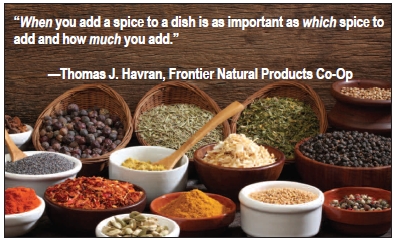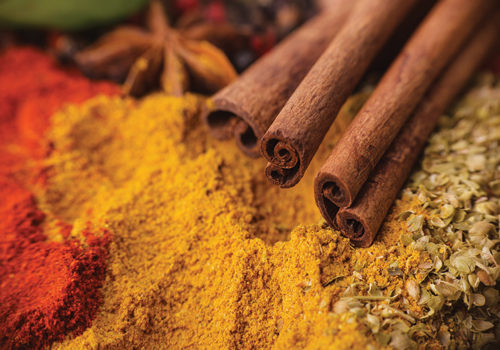With a wide enough selection and a nudge in the right direction, even your most cooking-averse customers will find themselves dashing in the sea salt and peppering over the stew. The spice suggestions to follow will surely bring variety to their palates and their lives, but before we can apply these tips to great and tasty result, we must learn the basics on approaching spices, along with a few extra insights that any aspiring home cook must know.
Spices in Abstract
Their purpose is to preserve, intensify and add intrigue to the experience of eating food. A weighty job, and yet spices all share a humble origin. They are simply dried out herbs, seeds, bark, roots or fruits from  various plants, explains Jacqueline Logan, public and media relations coordinator for Mountain Rose Herbs, Eugene, OR. Spices tend to be highly aromatic, she continues, and the oils they carry help create a distinctive sensory experience. Logan asks us to imagine for a moment cinnamon rolls, but without the cinnamon. A terrible thought, but it illustrates the importance of spices to our enjoyment of food.
various plants, explains Jacqueline Logan, public and media relations coordinator for Mountain Rose Herbs, Eugene, OR. Spices tend to be highly aromatic, she continues, and the oils they carry help create a distinctive sensory experience. Logan asks us to imagine for a moment cinnamon rolls, but without the cinnamon. A terrible thought, but it illustrates the importance of spices to our enjoyment of food.
Beyond this fundamental role, the impact of spices in the diets of U.S. consumers seems set to expand even further. Strongly flavored and ethnically authentic cooking, featuring all of the heat and flavor depth that spices can provide, are part of the new normal, says Thomas J. Havran, copy writer and communicator of natural living for Frontier Natural Products Co-Op. “As the distances between cultures and societies shrink, the sophistication of our palates is growing. Gone are the days when cooking needed to be simple, satisfying and bordering on the bland so as to accommodate untested, sheltered appetites,” he says.
With Frontier and its brand Simply organic dealing with over 60 individual spices and spices blends from various culinary traditions, Havran can assess what attracts us to certain spices. “One inference we can draw when we look at the flavor profiles of the most popular best sellers is that the elements of heat and depth are the seasoning priorities that many are looking to incorporate into their culinary style, regardless of the ethnicity of the cuisine at hand,” he says.
Cinnamon, red (cayenne) pepper, black pepper and curry blends all deliver heat when they are added to food, and always sell well for that reason. Spices such as cumin, turmeric, ginger and vanilla, meanwhile, offer sought-after notes of earthy depth and richness to one’s cooking, according to Havran.
 Then, there’s good old salt. Natural sea salt specifically, as opposed to iodized salt, is often linked to health benefits of all kinds, and Carla Delangre, vice president of Selina Naturally, Arden, NC, home of the Celtic Sea Salt Brand, says it is delicious and versatile, too. Sea salt, she says, can enhance and extend the flavor of food without making the “saltiness” factor overbearing.
Then, there’s good old salt. Natural sea salt specifically, as opposed to iodized salt, is often linked to health benefits of all kinds, and Carla Delangre, vice president of Selina Naturally, Arden, NC, home of the Celtic Sea Salt Brand, says it is delicious and versatile, too. Sea salt, she says, can enhance and extend the flavor of food without making the “saltiness” factor overbearing.
Many spices, Logan says, aid a healthy digestive system and have been used in different cultures for this reason, among others like fennel, cumin and celery seed from the Ayuryedic tradition. As a retailer, don’t ignore this component in promoting your spice offerings—so many people have digestive problems today that prospects for improvement are always welcome.
Production factors should be considered when dealing with spices from different sources and companies. Other than organic certification, such considerations might include being free of irradiation, and not being treated with ozone, sulfites, gasses and other sanitary chemicals, according to Logan. Look into the quality control assurances and supervision associated with a spice vendor, as well as whether spices are ethically wild-harvested, where applicable.
Finally, Logan says that freshness is key. You don’t want spices that come from old “warehouse stock.” She says, “When purchasing spices, be sure to consider the quality first by looking for vibrant colors and bold aromas. Using freshly dried organic spices will produce better results.”
Spices in Practice
Customers may enjoy certain spices when employed expertly by a restaurant chef, but could be afraid to use them at home. Encourage them to emulate the flavors of their favorite spices, and be bold. “Even inexperienced cooks, who might lack confidence when experimenting with flavor, can easily develop and enhance any dish with a dash or two of quality spices,” says Logan.
Sea salt’s versatility has been mentioned, and deep ocean  sea salt adds yet another layer, as Delangre explains. In its unaltered form, its high mineral and very low sodium content makes for a delicate ocean-infused salt flavor. When it comes time to use it in the kitchen, sea salt generally proves handy.
sea salt adds yet another layer, as Delangre explains. In its unaltered form, its high mineral and very low sodium content makes for a delicate ocean-infused salt flavor. When it comes time to use it in the kitchen, sea salt generally proves handy.
Delangre notes that her company deals in coarse, finely ground and delicate crystal varieties of sea salt. “The fine ground is perfect for baking, allowing for the ingredients to blend evenly. The coarse is perfect for cooking as it dissolves quickly in warm or hot dishes,” she says. The delicate variety, not surprisingly, is easily crushed between fingertips, making it suitable as a finishing salt or sometimes as an accent to rich desserts, she adds.
The large crystals and delicate flavor of deep ocean sea salt can complement any blend of spices, according to Delangre. Customers can make their own homemade “Herbes de Provence” with a mixture including the likes of deep ocean sea salt, lavender, rosemary, sage, oregano, thyme, basil and savory. “It’s a nice mix to have in your ceramic grinder to top chicken, vegetables or any dish you wish to add some rich herb flavor to,” she says.
Another suggestion for using deep ocean sea salt is in a combination with toasted sesame seeds and flax seeds. Mixing these three together in a grinder yields a nutty, toasty seasoning that Delangre says fits perfectly on salads, rice, veggies or shrimp, while supplying omega-3 fatty acids from the flax seeds.
 In any utilization of spice in cooking, the goal is never to mask or disguise the taste of the food. Complementing and enhancing flavors inherent to the dish is instead the desired result. “A good starting point is to begin with a basic recipe from a reliable source, then taste as you go. You can always add more, but can’t easily remove or balance food that has been over seasoned,” says Logan. Though there are usually many spices that can effectively mesh with a given dish, she says it is best to avoid using too many at once.
In any utilization of spice in cooking, the goal is never to mask or disguise the taste of the food. Complementing and enhancing flavors inherent to the dish is instead the desired result. “A good starting point is to begin with a basic recipe from a reliable source, then taste as you go. You can always add more, but can’t easily remove or balance food that has been over seasoned,” says Logan. Though there are usually many spices that can effectively mesh with a given dish, she says it is best to avoid using too many at once.
Logan puts forth some suggestions to get home-cooks started: cardamom can be paired with coffee, soups, ice cream and sweet or savory baked goods; fennel seeds go well with stews, seafood, rice, breads and tomato sauce; cinnamon can complement meats, cream sauce, desserts, tea and oatmeal; thyme is a match with citrus, eggs, cheeses, beans and poultry; and cayenne pepper serves well with chocolate, soups, nuts, grains and in meat rubs and hot sauces.
In many ethnic food traditions, seasoning practices revolve around extending the flavor range of basic ingredients by adding bright top notes and deep base notes of aroma and flavor, according to Havran. “The classic combinations of cumin and cayenne in Mexican and Indian cuisine and ginger and cayenne in Asian dishes are examples,” he says. Flavor balance, in these cases, is the goal.
Finally, Havran also emphasizes an important element in the process of using spices: “An often overlooked tip to keep in mind is that when you add a spice to a dish is as important as which spice to add and how much you add.” Spices are composed of complex flavor and aroma constituents, he says, and some of these release more readily into oil or fat, while others release into the watery parts of a dish. Still others are volatile enough to be lost quickly in any heating process.
Therefore, it’s often a useful technique to break up the measured amount of spices to be used in a dish into segments, which can then be added over the length of the cooking process. This will build layers that will balance and complete the flavor profile. Havran says one example is the use of cumin and red pepper in a chili powder blend. Both spices should be added at the beginning while sautéing the aromatics, again when deglazing with liquid components and one more time when the final blend is simmering. WF
Published in WholeFoods Magazine, January 2013









